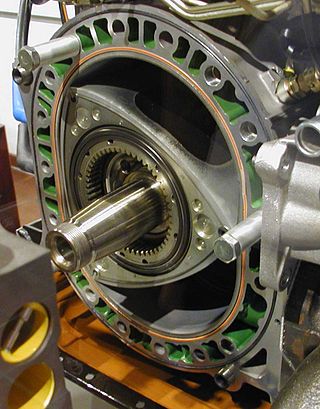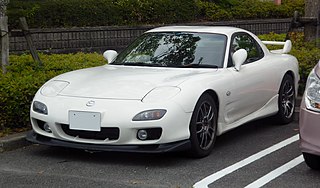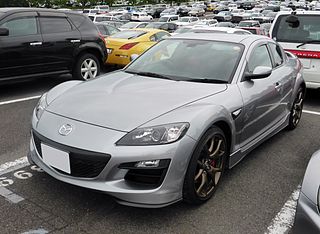
Mazda Motor Corporation, commonly referred to as simply Mazda, is a Japanese multinational automotive manufacturer headquartered in Fuchū, Hiroshima, Japan.

The Wankel engine is a type of internal combustion engine using an eccentric rotary design to convert pressure into rotating motion.

The Mazda RX-7 is a front-engine, rear-wheel-drive, rotary engine-powered sports car that was manufactured and marketed by Mazda from 1978 until 2002 across three generations, all of which made use of a compact, lightweight Wankel rotary engine.

The Mazda RX-8 is a sports car manufactured by Japanese automobile manufacturer Mazda between 2002 and 2012. It was first shown in 2001 at the North American International Auto Show. It is the successor to the RX-7 and, like its predecessors in the RX range, it is powered by a rotary Wankel engine. The RX-8 was available for sale in North America from the 2003 model year.

The Mazda Cosmo is an automobile which was produced by Mazda from 1967 until 1995. Throughout its history, the Cosmo served as a "halo" vehicle for Mazda, with the first Cosmo successfully launching the Mazda Wankel engine. The final generation of Cosmo served as Mazda's flagship vehicle in Japan, being sold as the Eunos Cosmo through its luxury Eunos division in Japan.

The Mazda Luce is an executive car that was produced by Mazda in Japan from 1966 until 1991. It was widely exported as the Mazda 929 from 1973 to 1991 as Mazda's largest sedan. Later generations were installed with luxury items and interiors as the Luce became the flagship offering. The Luce was replaced by the Sentia in 1991 which was also exported under the 929 nameplate.

The Mazda Wankel engines are a family of Wankel rotary combustion car engines produced by Mazda.

Mazda North American Operations (MNAO), which includes Mazda Motor of America, Inc., is Mazda Motor Corporation's North American arm, and constitutes the largest component of that company outside Japan. The company has its headquarters in Irvine, California and is headed by Masahiro Moro.
Hydrogen technologies are technologies that relate to the production and use of hydrogen as a part hydrogen economy. Hydrogen technologies are applicable for many uses.
Hybrid vehicle drivetrains transmit power to the driving wheels for hybrid vehicles. A hybrid vehicle has multiple forms of motive power.

The Toyota FCHV is a current hybrid hydrogen fuel cell vehicle development programme of the Toyota Motor Corporation, which was leased to a limited number of drivers in the United States and Japan beginning in 2002. "FCHV" stands for "Fuel Cell Hybrid Vehicle". A number of prototypes have been produced, up to the latest FCHV-adv ("advanced").

The Mazda RX-8 Hydrogen RE is a 2003 bi-fuel version of the RX-8 sports car, in which the twin-rotor wankel rotary engine is configured to run on either hydrogen or gasoline. This is the fifth Mazda vehicle to be fitted with a hydrogen wankel rotary engine.

The Mazda Grand Familia is an automobile which was produced by Mazda in Japan from 1971 to 1978. It was sold as the Mazda 808 in some export markets including Asia, Australia, and New Zealand, and as the Mazda 818 in many others - this was mostly due to Peugeot having trademarked three-digit numbers with a middle zero in many markets. The body style configurations offered were a two-door coupé, a four-door sedan, and a five-door station wagon. The Grand Familia offered only inline four cylinder engines. The largely identical rotary-powered versions were marketed as the Mazda Savanna in Japan, with export markets taking this model as the Mazda RX-3.

The Mazda Premacy is a passenger minivan that was built by the Japanese manufacturer Mazda from 1999 to 2018.
Skyactiv is a brand name for a series of automobile technologies developed by Mazda that increase fuel efficiency and engine output. The initial announcement of the Skyactiv technologies included new engines, transmissions, body, and chassis, which appeared in Mazda products from 2011 onwards.

The Mazda HR-X was the first hydrogen powered concept car produced by Mazda. The car was unveiled at the Tokyo Motor Show in 1991. The car seated four people in a plastic shell and was powered by a two rotor Wankel engine which propelled it to 130 km/h (81 mph). The hydrogen was stored in a cooled metal hydride tank and 3.32 kilograms (7.3 lb) provided a range of 190 km (120 mi). It was the first in a series of demonstration hydrogen internal combustion engine vehicles produced by Mazda.

The Mazda MX-30 is an electric and hybrid subcompact crossover SUV produced by Mazda. Based on the CX-30, it was unveiled at the 2019 Tokyo Motor Show. Production of the vehicle, which is Mazda's first mass-produced electric car, began at their Ujina factory on 19 May 2020.

The Mazda2 is a subcompact/supermini (B-segment) car manufactured and marketed by Mazda since 2002, currently in its third generation. An entry-level model of the brand in markets outside Japan, the Mazda2 is positioned below the Mazda3. The Mazda2 has also been marketed as the Mazda Demio, while its direct predecessor was exported as the Mazda 121.

The Hyundai Vision FK is a concept car that uses a plug-in hybrid drivetrain with both a large traction battery and a hydrogen fuel cell; the concept vehicle was developed by Hyundai and Rimac Automobili. The mid-motor, rear-wheel-drive sports coupe was unveiled at the Hydrogen Wave Forum in September 2021, an event organized by Hyundai to outline its plans to popularize hydrogen vehicles by 2040 for "Everyone, Everything and Everywhere". Power is delivered through two electric traction motors, both on the rear axle. The Vision FK can be plugged in to recharge its traction battery, which has more than 60 kW-hr of energy storage capacity, and the onboard fuel cell affords it a range greater than 600 km (370 mi).















